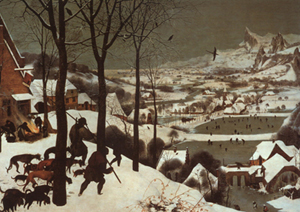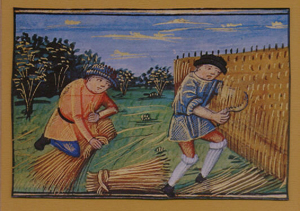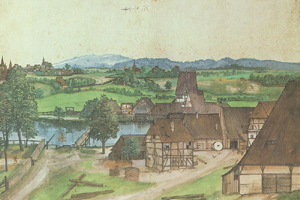
Rediscovering the American Heartland
Through European Masters

Rediscovering the American Heartland
Through European Masters
I began to write poetry after I moved from my native Indiana, where I had lived for twenty-six years, to metropolitan New York. The move was an uprooting that jolted me into looking back as well as within. Both my parents, of German descent, had grown up on farms. When I was ten we moved from the German-Catholic town of Jasper to a "subdivision" outside the city limits that contained more woods and fields than housing. My parents were such serious gardeners that even after their four children moved away from home, they continued to grow enough vegetables to feed a family of six. When I was a child, in the summer I helped with chores on my godfather's dairy farm, where my mother had lived as a girl, fished in the Patoka River or my grandmother's pond, picked blackberries which I sold to the bakery for a dollar a gallon, went camping with the boys scouts, and played baseball in town. As a teenager I helped local farmers and relatives haul hay. In August and early September I went into the woods before dawn with my father, relatives, or friends to hunt squirrels. In the fall we gathered hickory nuts and walnuts, I filled burlap bags with popcorn from a field which the farmer's machine had not picked clean, and I trapped rabbits and hunted quail with the bird dogs we kept in a pen in the woods behind our house.
For the first three years that I wrote poems, it was almost exclusively this rural world of my youth that I drew upon for the subjects of my poems. Later collected in Somewhere in Southern Indiana, these earliest poems grew out of a compulsion to stay in touch with the life--the people, places, and activities--from which I felt divorced when I moved to suburban Long Island in 1970.
In 1973-74, my wife and I lived in England as part of an exchange program. We lived in a 250-year-old stone cottage in Whitney, a medieval woolen town on the outskirts of the Cotswolds. When we woke in the morning, we could see cows grazing along the River Windrush. We went often to a working-class pub, The Harriers, with neighbors and colleagues from the technical college where I taught. We drove through Cotswold villages and countryside, walked public footpaths, revisited the ruins at Minster Lovell several miles away. Living in that stone cottage in a small town in a foreign country, I felt oddly at home, moreso than I'd felt for three years on Long Island.
For my birthday that year my wife Katherine gave me a block-mounted print
of a favorite painting, Pieter Brueghel the Elder's "Hunters in the Snow."  I
hung the Brueghel above the fireplace and every day for two months stared at
the scene, which triggered memories of my southern Indiana youth. I don't
recall when I realized that I must write a poem about that painting, but I do
recall that the realization filled me with anxiety. A year before, my friend
and colleague the sculptor Alfred Van Loen had asked me to write poems to
accompany his drawings of children's toys, I said yes immediately, then sat
paralyzed with the drawings for three months before my poet friend Nancy
Willard encouraged me to use them to free-associate into my childhood.
Shortly before we left for the year in England, I wrote nineteen childhood
poems in one week. Two of them, "Boy Scouts Camping Out" and "Sisters,"
later appeared in Somewhere in Southern Indiana.
I
hung the Brueghel above the fireplace and every day for two months stared at
the scene, which triggered memories of my southern Indiana youth. I don't
recall when I realized that I must write a poem about that painting, but I do
recall that the realization filled me with anxiety. A year before, my friend
and colleague the sculptor Alfred Van Loen had asked me to write poems to
accompany his drawings of children's toys, I said yes immediately, then sat
paralyzed with the drawings for three months before my poet friend Nancy
Willard encouraged me to use them to free-associate into my childhood.
Shortly before we left for the year in England, I wrote nineteen childhood
poems in one week. Two of them, "Boy Scouts Camping Out" and "Sisters,"
later appeared in Somewhere in Southern Indiana.
But it is one thing to write poems about your rural childhood inspired by a friend's drawings, another to draw upon your rural childhood to recreate the world of a medieval or Renaissance painting in a narrative poem. I drafted a poem about the scene above the fireplace and titled it "Returning from the Hunt" and wrote another about a second Brueghel painting that moved me, "Making Hay." Following the cycle of the seasons, the routine of rural occupations, memories of childhood and adolescence, and my eye as I turned and re-turned the pages of several beautiful books of Brueghel prints my wife gave me, I wrote "Harvesting Wheat," "Bringing Home the Herd," "A Gloomy Day," and called the cycle "Rural Lines After Brueghel." After finishing the cycle, which appeared in Poetry and, over twenty years later, in the middle section of Blue-Eyed Grass: Poems of Germany, "Landscapes of the Masters," I learned that a nobleman had commissioned Brueghel to do the paintings as a group. If I had remembered at the time that John Berryman and William Carlos Williams had written poems about my favorite painting, "Hunters in the Snow," I'm sure I would have been too intimidated to write "Returning from the Hunt" and the entire Brueghel cycle.
In the bookshop of the Victoria and Albert Museum in London that spring I
came across reproductions of the twelve occupations of the month (pruning,
harvesting hay, reaping, butchering, etc.), from a fifteenth century book of
hours.  These illuminations, more primitive than ones I had seen in other
books of hours, appealed to me so much that after returning to Long Island I
wrote one poem for each month. These twelve poems, with halftone
reproductions of the illuminations, were published as my first chapbook, The
Playfair Book of Hours, by the Ally Press in 1976. Like the Brueghel cycle,
the poems in Playfair follow the cycle of the seasons and the routine of
rural work, but the center of attention shifts somewhat from the earth and
its cycles to human relationships, a focal point in the Dürer cycle to come.
These illuminations, more primitive than ones I had seen in other
books of hours, appealed to me so much that after returning to Long Island I
wrote one poem for each month. These twelve poems, with halftone
reproductions of the illuminations, were published as my first chapbook, The
Playfair Book of Hours, by the Ally Press in 1976. Like the Brueghel cycle,
the poems in Playfair follow the cycle of the seasons and the routine of
rural work, but the center of attention shifts somewhat from the earth and
its cycles to human relationships, a focal point in the Dürer cycle to come.
While I was writing the autobiographical southern Indiana poems and those
set in the late Middle Ages or Renaissance, I was also researching my family
history. Eventually, I learned that both sides of my family lived in the
northern part of Bavaria, known as Franconia, until the middle of the
nineteenth century. My interest in German art, together with my background
in hunting, inspired a poem based on a Cranach painting, "Stag Hunt," that
later became part of Blue-Eyed Grass.  By the time I wrote the Cranach
poem, I was studying the painting, writing, and life of Albrecht Dürer, who
lived in my ancestral Franconia. During the summer of 1976, while living on
an ancient farm in Schwäbisch Hall in nearby Baden-Württemberg, I made
several visits to Dürer's house and grave in the Johannisfriedhof in
Nürnberg. In January 1977 I began a cycle of narrative poems based on his
life and works; but I could never have written about Albrecht Dürer, a man of
multiple talents and obsessions, if I had not felt at home in the world of my
ancestral Franconia. The story of Dürer's education as a young man, his
development as an artist, and his emergence as a public figure with an
international reputation challenged me to move beyond individual works of art
into the concentric worlds they evoked. As an artist, Dürer was a genius
whose breadth, depth, and versatility allowed him to reach different kinds of
people in many countries, but his relationships with his mother, father, and
wife kept him grounded in the quotidian. My narrative cycle Lines Drawn
from Dürer appeared, with reproductions of Dürer's art, as a chapbook from
Ally Press in 1980 and became the center piece of the middle section of
Blue-Eyed Grass.
By the time I wrote the Cranach
poem, I was studying the painting, writing, and life of Albrecht Dürer, who
lived in my ancestral Franconia. During the summer of 1976, while living on
an ancient farm in Schwäbisch Hall in nearby Baden-Württemberg, I made
several visits to Dürer's house and grave in the Johannisfriedhof in
Nürnberg. In January 1977 I began a cycle of narrative poems based on his
life and works; but I could never have written about Albrecht Dürer, a man of
multiple talents and obsessions, if I had not felt at home in the world of my
ancestral Franconia. The story of Dürer's education as a young man, his
development as an artist, and his emergence as a public figure with an
international reputation challenged me to move beyond individual works of art
into the concentric worlds they evoked. As an artist, Dürer was a genius
whose breadth, depth, and versatility allowed him to reach different kinds of
people in many countries, but his relationships with his mother, father, and
wife kept him grounded in the quotidian. My narrative cycle Lines Drawn
from Dürer appeared, with reproductions of Dürer's art, as a chapbook from
Ally Press in 1980 and became the center piece of the middle section of
Blue-Eyed Grass.
In the poems which draw on my southern Indiana background or the details of late medieval or early Renaissance art, I try to dramatize what I feel are timeless aspects of the human condition. When a student from France looked at Playfair and said that it was "not American," I countered: "Of course it is! In the Middle Ages my ancestors were peasants who worked in the fields of Europe." When an American friend read "Stag Hunt" and said, "You should have lived in the Middle Ages," I replied: "I did. And still do." But I also lived in nineteenth century America, the setting of "The Forefather Arrives" and other poems in Somewhere in Southern Indiana. Since 1970 I have been living on Long Island, the setting, both past and present, of the chapbook Arriving on Paumanok and the unpublished full-length collection Bittersweet Along the Expressway: Poems of Long Island. I hope that as my longer collections of poems continue to appear in print, these various times, places, and people will emerge, in context, as one.
This essay, to be included in the unpublished Where It All Began: A Search for Origins, originally appeared in PLA Report 8 (1982), 2. The same issue includes Joan Huntoon's review of Lines Drawn from Dürer, p. 41.
www.krapfpoetry.net